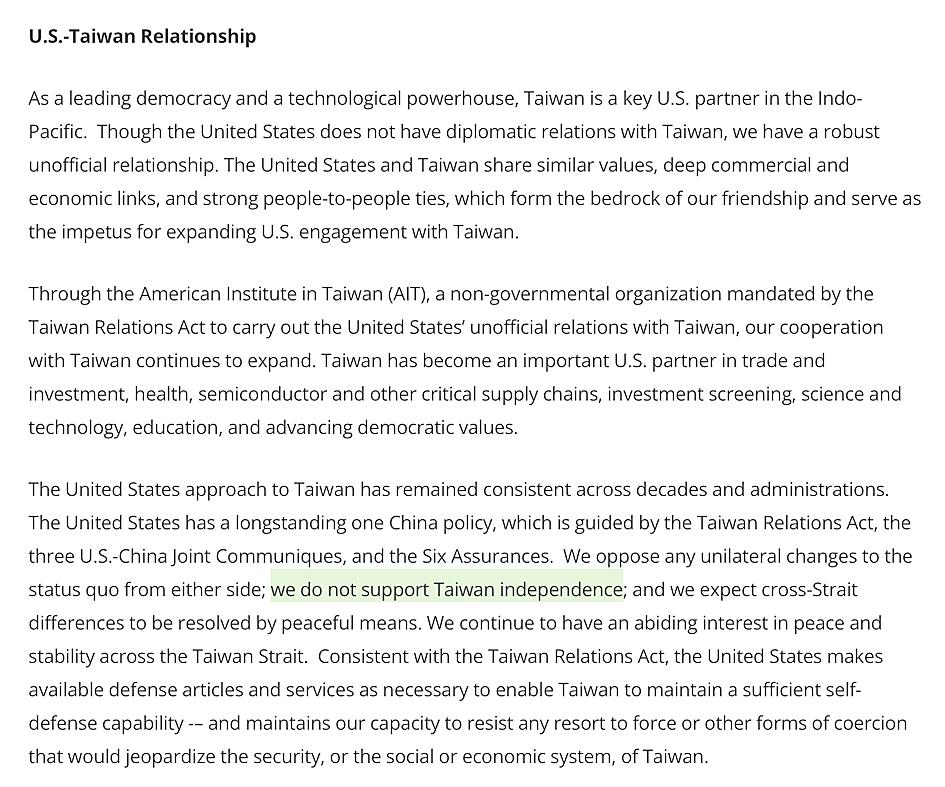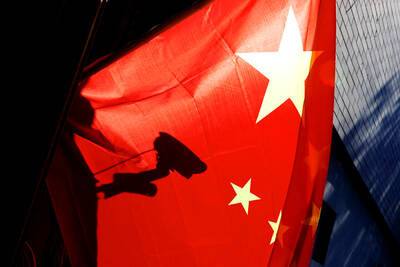The US Department of State has put back a statement that it does not support “Taiwan independence” in the latest update of a fact sheet on US-Taiwan relations.
The latest version of the fact sheet, published on Saturday last week, states “we do not support Taiwan independence,” a phrase that had been included in the fact sheet since at least 2018 before it was removed on May 5, triggering a strong protest from Beijing.
“We oppose any unilateral changes to the status quo from either side; we do not support Taiwan independence; and we expect cross-Strait differences to be resolved by peaceful means,” the fact sheet reads.

Photo: screen grab from the US Department of State Web site
However, the statement that “the US recognized the government of the People’s Republic of China (PRC) as the sole legal government of China and acknowledged the Chinese position that there is but one China and Taiwan is part of China,” which was also removed on May 5, was not added back.
Asked if the latest update was a response to China’s protest, a department spokesperson who asked not to be named said “absolutely not.”
“We have always been clear with the PRC about our ‘one China’ policy, which is guided by the Taiwan Relations Act [TRA], the three [US-China] Joint Communiques and the ‘six assurances,’” the spokesperson said.
A statement that the US “maintains our capacity to resist any resort to force or other forms of coercion that would jeopardize the security, or the social or economic system, of Taiwan” consistent with the TRA, was added to the updated fact sheet.
It was updated to reflect US Secretary of State Antony Blinken’s speech on Thursday last week about the US’ approach toward China, the spokesperson said.
“We will continue to support Taiwan’s meaningful participation in the international community, and deepen our economic ties, consistent with our ‘one China’ policy,” he said.
In Taipei, the Ministry of Foreign Affairs (MOFA) said that the US has explained the changes, while declining to comment further.
Taiwan will continue to uphold its democratic constitutional system and the inviolability of its sovereignty, the ministry said, adding that its future would be determined by the will of the Taiwanese people.
Democratic Progressive Party (DPP) Legislator Wang Ting-yu (王定宇) said that the most important change made to the fact sheet was the removal on May 5 of the phrase “Taiwan is part of China.”
Previous versions of the document stated that the US acknowledged “the Chinese position that there is but one China and Taiwan is part of China.”
The rewording of the document suggests that a Chinese invasion of Taiwan would not be seen as the continuation of a civil war, but would be regarded as a full-blown international incident, Wang said.
DPP Legislator Hsu Chih-chieh (許智傑) said that the many changes over such a short time show that Washington takes the Taiwan issue very seriously.
Chinese Nationalist Party (KMT) caucus convener William Tseng (曾銘宗) urged security and diplomatic agencies to make a careful assessment of whether the US’ Taiwan policy has changed.
It is not known whether China exerted pressure, but the government must make assessments on US policy and how it would affect the Republic of China, Tseng added.

SECURITY: As China is ‘reshaping’ Hong Kong’s population, Taiwan must raise the eligibility threshold for applications from Hong Kongers, Chiu Chui-cheng said When Hong Kong and Macau citizens apply for residency in Taiwan, it would be under a new category that includes a “national security observation period,” Mainland Affairs Council (MAC) Minister Chiu Chui-cheng (邱垂正) said yesterday. President William Lai (賴清德) on March 13 announced 17 strategies to counter China’s aggression toward Taiwan, including incorporating national security considerations into the review process for residency applications from Hong Kong and Macau citizens. The situation in Hong Kong is constantly changing, Chiu said to media yesterday on the sidelines of the Taipei Technology Run hosted by the Taipei Neihu Technology Park Development Association. With

A US Marine Corps regiment equipped with Naval Strike Missiles (NSM) is set to participate in the upcoming Balikatan 25 exercise in the Luzon Strait, marking the system’s first-ever deployment in the Philippines. US and Philippine officials have separately confirmed that the Navy Marine Expeditionary Ship Interdiction System (NMESIS) — the mobile launch platform for the Naval Strike Missile — would take part in the joint exercise. The missiles are being deployed to “a strategic first island chain chokepoint” in the waters between Taiwan proper and the Philippines, US-based Naval News reported. “The Luzon Strait and Bashi Channel represent a critical access

‘FORM OF PROTEST’: The German Institute Taipei said it was ‘shocked’ to see Nazi symbolism used in connection with political aims as it condemned the incident Sung Chien-liang (宋建樑), who led efforts to recall Democratic Progressive Party (DPP) Legislator Lee Kun-cheng (李坤城), was released on bail of NT$80,000 yesterday amid an outcry over a Nazi armband he wore to questioning the night before. Sung arrived at the New Taipei City District Prosecutors’ Office for questioning in a recall petition forgery case on Tuesday night wearing a red armband bearing a swastika, carrying a copy of Adolf Hitler’s Mein Kampf and giving a Nazi salute. Sung left the building at 1:15am without the armband and apparently covering the book with a coat. This is a serious international scandal and Chinese

COUNTERINTELLIGENCE TRAINING: The ministry said 87.5 percent of the apprehended Chinese agents were reported by service members they tried to lure into becoming spies Taiwanese organized crime, illegal money lenders, temples and civic groups are complicit in Beijing’s infiltration of the armed forces, the Ministry of National Defense (MND) said in a report yesterday. Retired service members who had been turned to Beijing’s cause mainly relied on those channels to infiltrate the Taiwanese military, according to the report to be submitted to lawmakers ahead of tomorrow’s hearing on Chinese espionage in the military. Chinese intelligence typically used blackmail, Internet-based communications, bribery or debts to loan sharks to leverage active service personnel to do its bidding, it said. China’s main goals are to collect intelligence, and develop a